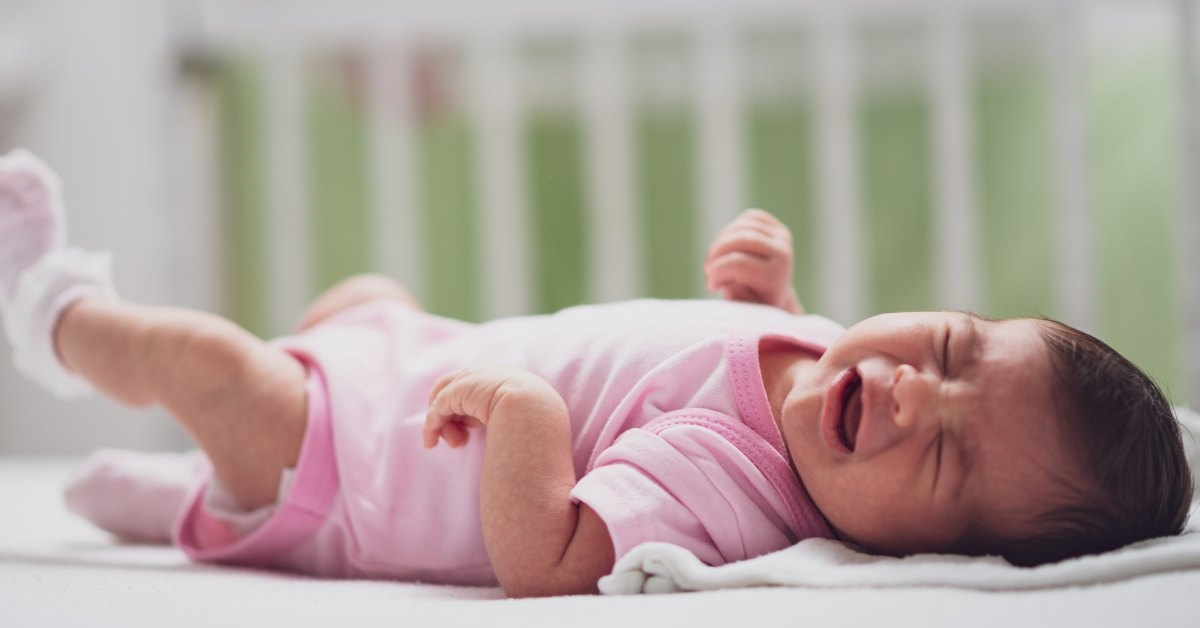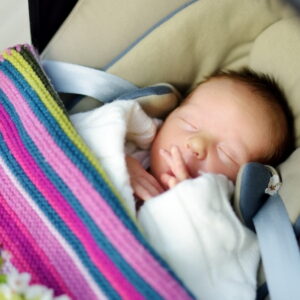Baby refuses crib sleeping? Many babies seem to think sleeping in a crib is a lousy idea, and they start crying immediately when you try to put them down. Mom’s arms are so much cozier.
Here is why this happens and what you can do to make your baby accept the crib.

Is it difficult to make your baby sleep well in the crib? Or maybe even at all? A baby refusing crib sleeping is a common situation and can happen both when they are newborns and later on. Since co-sleeping is heavily disputed due to safety concerns, many parents desperately want their babies to accept the crib. Parents’ sleep deprivation from having a baby that cries every time they’re put down is also an important reason to help the baby accept crib sleeping.
Learn here why babies often refuse the crib, and then implement the tips below to help your baby accept the crib. It can be done!
Why Do Babies Refuse Crib Sleeping?
Many infants seem to think that sleeping in a crib is a really lousy idea. Mom’s arms are so much cozier. And, of course, they are. But not around the clock because then mom tends to become veeeery exhausted. But remember that wanting to be close to their caregivers is a good sign of bonding, so even if you need your child to learn to sleep in the crib, there is nothing wrong with them resisting it.
Here are some of the most common reasons babies refuse crib sleeping:
1. It’s a cold, empty place
Your baby is used to the warmth of your arms or your womb. A crib is just a cold, large, empty space.
2. It is something new
Babies need to feel secure and love routines. If their routine is to sleep in your arms or your womb, they will not feel safe in the beginning in a crib and will let you know.
3. Pain and illnesses
If your baby has acid reflux, which is quite common in young babies, being placed on their back on a flat mattress to sleep can actually be painful! The same goes if a baby has an ear infection or a stopped-up nose. Sleeping on a flat mattress can be very uncomfortable.
Babies may also wake up or have trouble falling asleep due to teething pain or medical issues.
If you suspect pain or illness-related reasons for your baby’s crying, make sure to sort this out with your baby’s healthcare provider before trying to teach them to accept the crib.
4. They get overtired and don’t know how to fall asleep
If your baby is used to being rocked to sleep in your arms or womb, they may not be able to fall asleep in a crib. Young babies often also have a strong feeding-to-sleep association and may not be able to fall asleep, stay asleep, or go back to sleep without a nipple in their mouth.
5. Stressful situation
If you feel stressed or have turned the crib sleeping into a power struggle with your baby, your child will have a poor experience and a negative association with the crib.
6. Separation Anxiety
At around six months of age, it is common that separation anxiety sets in. At this age, our babies start understanding object permanence, i.e., things and people are around even if they can’t see them. They will miss you and feel stressed when you are out of sight. Your baby will be anxious when you are out of sight and may be unable to fall asleep alone. Six to ten months is a common age for sleep regression due to separation anxiety. It may happen with toddlers, too.
7. Feeding-to-Sleep Association
Many babies become dependent on feeding to fall asleep. To be honest, this is our own “fault” as new parents, as we let our newborns fall asleep at the breast or bottle over and over again.
8. Associated with nightmares or night terrors
Older babies and young toddlers may associate the crib with nightmares or night terrors. If they have woken up at night terrified enough many times, they may start refusing the crib due to the negative associations.
So, as you can see, there may be many valid reasons why your baby refuses crib sleeping. The key is to help them like it!
There are things you can do to help your baby feel safe and comfortable while sleeping in a crib. Just remember that you can’t change a baby’s routine in just a day. Babies are routine lovers and need their parents’ warmth to feel safe. Give it a week at least while implementing the tips below.
Do you need tips on how to buy the right crib for your baby? Click here.
How To Get Your Baby To Accept The Crib
- Make the bed smaller
- The Smell of Mom or Dad
- Nice temperature
- Add some white noise
- Swaddling
- Break feeding-to-sleep association
- Introduce a pacifier
- Put your baby to bed awake
- Test the Timing
- Or wait until deep sleep
- Start with the Naps
- Make it a new routine
- If baby refuses crib sleeping no matter what you do…
1. Make the bed smaller
A newborn baby with poor eyesight and used to the womb’s very warm, narrow environment will find the crib a super scary place! Make newborn your infant’s huge (in his or her view) bed smaller. Put rolled blankets or sheets in a circle to make the perceived sleeping place as small as possible. (Just make sure they are rolled and secured so they can’t fall over your baby!)
Newborn babies also often seem to want to have something soft close to their heads to feel like they are in a safe place. A rolled small blanket or towel close to the top of their head can make a huge difference for them. Again, just make sure you don’t put anything in the bed that can fall over his or her face. Remove the blanket once your baby has fallen asleep and appears to be in deep sleep.
Making the bed seem smaller can really help when a newborn baby refuses crib sleeping. It will most likely not help older babies that need space.
2. The Smell of Mom or Dad
Roll up a shirt that you have worn and put it close to your baby’s head as part of the small bed you’re making.
If the bed smells like mom (or dad), your baby is likely to feel safer.
Again, the shirt should be removed for safety reasons once your baby is asleep.
One option is that you sleep with your baby’s sheet in your bed for a couple of days before making the crib with it. This way, the crib will have your smell without putting anything extra (that might be unsafe) in your baby’s crib.
3. Nice temperature
Before putting your baby in bed, make sure the bed is not too cold. You can either put a warm (not hot) water bottle (or something similar) in the bed for a while before putting your baby down or, even better, use a sleep sack for your baby. With a sleeping bag, your baby will enjoy more or less the same temperature all the time, helping him or her to stay comfortable.
Sleep sacs (basically wearable blankets) are excellent in many ways, especially during the first months. As you may have noticed, especially breastfed babies often poop every time they eat in the beginning. This means you will have to change diapers at night from time to time.
With a sleeping bag that opens easily for a diaper change, you might be able to change diapers without making your baby wide awake since he or she won’t get cold. I used a sleeping bag that could be opened at the bottom without opening the zipper all the way up. It was great. My baby slept through the diaper change, never woke up for being warm or cold, and I could relax because I knew my baby was safe compared to under a blanket.
If you use a water bottle or bean bag, make sure the bed doesn’t become too warm, and take it out before putting your baby in the crib.
4. Add White Noise
Some babies sleep and fall asleep much better to white noise than in a completely silent environment. Some babies, especially newborns, will even sleep better in the middle of the room despite older siblings running around.
With one of our babies, we even carried her bassinet around to have her sleep in whatever room we were in, including the kitchen, because she slept a lot better and for longer stretches there than in a dark, silent bedroom. Of course, for older babies and crib sleeping, this is not an option, but you can still add white noise and see if it helps.
These four tips above all aim at making the crib more cozy for the baby. While soft bedding and pillows should not be added due to the increased risk of SIDS, you can come a long way with ensuring a small enough space, a once temperature, the smell of mom and dad, and white noise. Do some experimenting to see what works best for your baby.
In addition to making the crib cozy, there are a number of other things you can do too:
5. Swaddling
If your baby is between newborn and a few months of age, you can also consider swaddling him or her.
In the beginning, you can swaddle the whole body, but at six weeks old or so, your baby’s arms (or at least one of them) should be free. At this time, the baby might start using his or her hands for self-soothing or to communicate hunger by sucking the hand.
Don’t know how to swaddle a baby? For more detailed instructions (and video) on how to swaddle your baby, click here.
A swaddled baby may feel more secure and, therefore, be less prone to refuse crib sleeping. A swaddle may also prevent young babies from being woke up by the startle reflex, or Moro reflex, as it is also called. This is the reflex that makes babies flay out with their arms and legs when startled.
6. Break the feeding-to-sleep association
If your baby is used to feeding to sleep (very common!), don’t expect them to start falling asleep in the crib just because you want them to – they literally can’t! In this case, the first thing you need to do is to help them break the feeding-to-sleep association. This may be a quicker or longer process depending on how old your baby is and how used they are to fall asleep at your breast or the bottle.
You can still work on helping them get used to sleeping in the crib, with all the tips brought up here, but until they have learned to fall asleep without feeding, it will be difficult to have them fall asleep on their own.
7. Introduce a pacifier
For some babies, a pacifier will help them accept crib sleeping. The suckling reflex can be strong, and if they feel soothed by the pacifier, they may find it easier to fall asleep in the crib with it. Pacifier usage actually has some clear benefits, such as reducing the risk of sudden infant death syndrome, so there are other reasons to introduce a pacifier, too.
It is true that young babies often lose their pacifier once asleep, and that can make them wake up. It’s frustrating for sure, but for older babies, this is easily fixed by putting a large number of pacifiers in the crib so they can easily find one and put it back in. You can also pull out the pacifier as soon as the baby is sound asleep so they learn to sleep without sucking on it.
8. Put your baby to bed awake
Young babies can often be put to bed while still awake if full, happy, and tired. This actually works great for many babies at around three weeks of age.
Simply put your baby down for crib sleeping, say goodnight, and leave the room. You might be up for a surprise! This is much harder with older babies, who are more aware of what’s happening and may be prone to separation anxiety. But you can always try!
Consider placing a musical mobile over the crib for the baby to have something to look at and listen to.
Personally, I’m not fond of the cry-it-out method, especially not for young babies, so my advice is not to force this with some strict sleep training. If your baby starts crying, cuddle him or her first in the crib, but if that doesn’t help, let your child fall asleep (or almost fall asleep) in your arms. Then, put him or her down.
For a lot more baby sleep tips, visit our baby sleep section.
9. Test the Timing
Unless your baby appreciates the crib and enjoys lying there to, for example, watch and listen to the músical mobile and then slowly doze off, it may be efficient to play around a little bit with when you put your baby down awake. An overtired baby may not be able to calm down without your help, but one who is full, content, and sleepy may just drift off to sleep with some luck.
10. Or Wait Until Deep Sleep
If your baby wants nothing to do with the crib, it may be more efficient to move them to it when they are in deep sleep as a first step. A baby in deep sleep will be relaxed and still.
If they get used to waking up in the crib, it may be easier to start putting them down when awake or almost awake after a little while.
11. Start with the naps
Sometimes, it is easier to start introducing the crib for naps. During the daytime, you may be able to get your baby to fall asleep in, for example, the stroller or infant car seat and then transfer them to the crib when they are no longer in active sleep (rapid eye movement sleep) but rather in a deep sleep. This way, they will wake up in the crib and get used to it. Make the wake-up moment nice and cuddly, and if possible, keep the baby in the crib awake for a little while while cuddling and interacting to make them associate the crib with something positive.
At nap time, you are also likely to be less exhausted and may have more time and patience with slowly helping your baby to fall asleep on their own, so you are less likely to transfer stress to your baby.
12. Make it a new routine
Rome wasn’t built in one day, and the same goes for changing a baby’s sleep routine. If you really want your baby to start sleeping in his crib, be persistent, but take it in baby steps.
Implement all the tips above and always put your baby in his crib, at least after he or she has fallen asleep in your arms. Every time. This way, your baby will learn – fast or slowly, that this is the place to sleep.
In addition, make it a nice and predictable bedtime routine. Take a deep breath and make sure you don’t transfer stress or frustration to your baby.
13. If baby refuses crib sleeping no matter what you do…
If your baby refuses crib sleep no matter what you do, you have two choices: switch to some other type of bed or let your baby sleep in your bed one way or the other.
Switching to some other type of bed means different things for different babies. Something smaller than a crib, like a cradle or a stroller, is usually more accepted by younger babies. (Although strollers are certainly not an option for night sleep.) After the age of 5 to 6 months, it is often the opposite – for older babies, cradles and bassinettes are too narrow to allow the baby to move around freely and safely while asleep.
The other option is to consider co-sleeping. Many babies sleep a lot better together with their parents.
However, if you or your husband smoke, if the bed is very soft, or if any of you have consumed alcohol, co-sleeping can be very dangerous for the baby, especially for young babies. While co-sleeping is common, it is recommended against by the American Academy of Pediatrics due to the risks. The situation is tricky since recommendations and reality are quite far apart.
You can read about co-sleeping risks, benefits, and alternatives in this article
One thing to remember is that while many newborn babies really only want to sleep in their mom’s or dad’s arms, things usually get easier over time. If your baby refuses crib sleeping now, try again in a few weeks.
For safety sleeping tips (to reduce the risk of SIDS), read this article.
Now, how do you survive until your baby sleeps better? Follow this link for some tips that don’t really help your infant sleep better, but you!
Is your baby refusing crib sleeping, too? Or do you have additional tips to share on getting a baby to accept the crib? Please share by leaving a comment below! :-)

Read Next
- Baby Only Sleeps and Naps When Breastfeeding! Here’s What to Do (No Cry It Out)
- 4 Month Old Won’t Sleep In Crib Or Bassinet
- 8-Month-Old Won’t Sleep In His Crib: What To Do?
- 6-Month-Old Nursing to Sleep And Refuses The Crib, Help!
- Newborn Baby Won’t Sleep In Crib: Why And What To Do?

Paula Dennholt founded Easy Baby Life in 2006 and has been a passionate parenting and pregnancy writer since then. Her parenting approach and writing are based on studies in cognitive-behavioral models and therapy for children and her experience as a mother and stepmother. Life as a parent has convinced her of how crucial it is to put relationships before rules. She strongly believes in positive parenting and a science-based approach.
Paula cooperates with a team of pediatricians who assist in reviewing and writing articles.








Great content but I’m struggling with my own situation. As a single, working and nursing mom, I have ended up co-sleeping for easier nursing therefore my 10 month old has always been a bad sleeper for me unless I’m snuggled up with her. Now that she is able to sit up and crawl with an adventurous spirit, I have caught her almost jumping off the bed. I feel like I have tried everything to move her into the crib. She just stands at the edge and cries. I have stood over her with my arms around her in a lying position to keep her from standing back up and she just looks up at me with a look of despair. She is my everything and I just want her to be safe in her crib at night. I hate the cry it out method but tried it and she kept going far beyond the other mothers comments so I grabbed her and took a break from crib training for a couple of weeks. What is there left to do?
Wonderful information, thanks a lot for sharing kind of content with us. Your blog gives the best and the most interesting information on crib sleeping. I wonder if we can gather such practical information about it, a great post definitely to come across.
Thank you! :-)
Swaddling was my favorite tip ever! It made such a difference for my little one.
I’ve had this book about sleep training – https://parental-love.com/shop/baby-sleep-training – but with tips for newborns as well. there was swaddling and white noise. Both very helpful but especially the wrapping – with drawings and all. My baby loved it!
My 14 months old has always loved her stroller but also sometimes fallen asleep in her crib… but now she completely refuses the crib, stands up and starts crying very loud the second she’s in, only calming down when we pick her up, never even sitting down in the crib. This makes sleep training very tough (we did it with our oldest who was more mild, calm and crying alternatively, happy when we would come sah shhht etc). The stroller is not safe anymore as she can now get out in the morning and fall…. also, we always put her in her bed eventually, asleep, and she always wakes up middle of the night, crying of course because she’s in her crib. So we end up with her in our bed which is so bad for all of us… (our own sleep, our oldest jealousy, and our youngest’s nights)
At 14 months, I’d say this is completely normal behavior! And being an exhausted mom is very normal too… If there is any possible way, let her to sleep in your bed, you need to sleep. You can break that habit later on. Or put a bed or mattress in your room for her – or for one of you if the bed gets too crowded!.
In my experience, kids tend to come back to our beds from time to time for many years when they need it. Only no one tells us this, Take it one day at the time, and focus on feeling good. It will make your daughter feels more secure too.
Regarding the older sibling’s jealousy – of course, normal too! Try to reinforce how “big” your older child is and make the evenings really nice for him/her too.
Good luck!